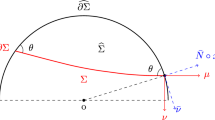Abstract
In this paper, we study the locally constrained inverse curvature flow for hypersurfaces in the half-space with \(\theta \)-capillary boundary, which was recently introduced by Wang et al. (Math Ann 388:2121–2154, 2024). Assume that the initial hypersurface is strictly convex with the contact angle \(\theta \in (0,\pi /2].\) We prove that the solution of the flow remains to be strictly convex for \(t>0,\) exists for all positive time and converges smoothly to a spherical cap. As an application, we prove a complete family of Alexandrov–Fenchel inequalities for convex capillary hypersurfaces in the half-space with the contact angle \(\theta \in (0,\pi /2].\) Along the proof, we develop a new tensor maximum principle for parabolic equations on compact manifold with proper Neumann boundary condition.


Similar content being viewed by others
Data Availability Statement
Data sharing not applicable to this article as no datasets were generated or analysed during the current study.
References
Andrews, B.: Pinching estimates and motion of hypersurfaces by curvature functions. J. Reine Angew. Math. 608, 17–33 (2007)
Andrews, B., Chen, X., Wei, Y.: Volume preserving flow and Alexandrov–Fenchel type inequalities in hyperbolic space. J. Eur. Math. Soc. 23(7), 2467–2509 (2021)
Andrews, B., Wei, Y.: Quermassintegral preserving curvature flow in hyperbolic space. Geom. Funct. Anal. 28(5), 1183–1208 (2018)
Andrews, B., Hu, Y., Li, H.: Harmonic mean curvature flow and geometric inequalities. Adv. Math. 375, 28 (2020)
Andrews, B., McCoy, J., Zheng, Y.: Contracting convex hypersurfaces by curvature. Calc. Var. Partial Differ. Equ. 47(3–4), 611–665 (2013)
Brendle, S., Guan, P., Li, J.: An inverse curvature type hypersurface flow in space forms. Preprint
Chen, M., Sun, J.: Alexandrov-Fenchel type inequalities in the sphere. Adv. Math. 397, 25 (2022)
Chen, C., Guan, P., Li, J., Scheuer, J.: A fully-nonlinear flow and quermassintegral inequalities in the sphere. Pure Appl. Math. Q. 18(2), 437–461 (2022)
Colding, T.H., Minicozzi, W.P., II: A Course in Minimal Surfaces. Graduate Studies in Mathematics, vol. 121. American Mathematical Society, Providence (2011)
Ge, Y., Wang, G., Wu, J.: Hyperbolic Alexandrov–Fenchel quermassintegral inequalities II. J. Differ. Geom. 98(2), 237–260 (2014)
Gerhardt, C.: Flow of nonconvex hypersurfaces into spheres. J. Differ. Geom. 32(1), 299–314 (1990)
Gerhardt, C.: Curvature Problems. Series in Geometry and Topology, vol. 39. International Press, Somerville (2006)
Guan, P.: Curvature measures, isoperimetric type inequalities and fully nonlinear PDEs. In: Gutiérrez CE, Lanconelli E (eds) Fully Nonlinear PDEs in Real and Complex Geometry and Optics. Lecture Notes in Mathematics, vol 2087. Springer, Cham (2014)
Guan, P., Li, J.: The quermassintegral inequalities for k-convex starshaped domains. Adv. Math. 221, 1725–1732 (2009)
Guan, P., Li, J.: Isoperimetric type inequalities and hypersurface flows. J. Math. Study 54(1), 56–80 (2021)
Hamilton, R.: Three-manifolds with positive Ricci curvature. J. Differ. Geom. 17, 255–306 (1982)
Hamilton, R.: Four-manifolds with positive curvature operator. J. Differ. Geom. 24, 153–179 (1986)
Hu, Y., Li, H.: Geometric inequalities for hypersurfaces with nonnegative sectional curvature in hyperbolic space. Calc. Var. Partial Differ. Equ. 58(2), 20 (2019)
Hu, Y., Li, H., Wei, Y.: Locally constrained curvature flows and geometric inequalities in hyperbolic space. Math. Ann. 382, 1425–1474 (2022)
Huisken, G., Polden, A.: Geometric evolution equations for hypersurfaces. In: Hildebrandt S, Struwe M (eds) Calculus of Variations and Geometric Evolution Problems. Lecture Notes in Mathematics, vol. 1713. Springer, Berlin (1999)
Lambert, B., Scheuer, J.: A geometric inequality for convex free boundary hypersurfaces in the unit ball. Proc. Am. Math. Soc. 145(9), 4009–4020 (2017)
Li, H., Wei, Y., Xiong, C.: A geometric inequality on hypersurface in hyperbolic space. Adv. Math. 253, 152–162 (2014)
Lieberman, G.M.: Second Order Parabolic Differential Equations. World Scientific Publishing Co., Inc., River Edge (1996)
Maggi, F.: Sets of Finite Perimeter and Geometric Variational Problems: An Introduction to Geometric Measure Theory. Cambridge Studies in Advanced Mathematics, vol. 135. Cambridge University Press, Cambridge (2012)
Makowski, M., Scheuer, J.: Rigidity results, inverse curvature flows and Alexandrov–Fenchel type inequalities in the sphere. Asian J. Math. 20(5), 869–892 (2016)
McCoy, J.A.: Mixed volume preserving curvature flows. Calc. Var. Partial Differ. Equ. 24(2), 131–154 (2005)
Mei, X., Wang, G., Weng, L., Xia, C.: Alexandrov–Fenchel inequalities for convex hyper-surfaces in the half-space with capillary boundary II. Preprint
Scheuer, J., Wang, G., Xia, C.: Alexandrov–Fenchel inequalities for convex hypersurfaces with free boundary in a ball. J. Differ. Geom. 120, 345–373 (2022)
Schneider, R.: Convex Bodies: The Brunn–Minkowski Theory. Encyclopedia of Mathematics and Its Applications, vol. 151, 2nd expanded edn. Cambridge University Press, Cambridge (2014)
Stahl, A.: Regularity estimates for solutions to the mean curvature flow with a Neumann boundary condition. Calc. Var. Partial Differ. Equ. 4, 385–407 (1996)
Ural’tseva, N.N.: A nonlinear problem with an oblique derivative for parabolic equations, Zap. Nauchn. Sem. Leningrad. Otdel. Mat. Inst. Steklov. (LOMI) 188 (1991); Kraev. Zadachi Mat. Fiz. i Smezh. Voprosy Teor. Funktsiói. 22, 143–158, 188; translation in J. Math. Sci. 70(3), 1817–1827 (1994)
Urbas, J.I.E.: On the expansion of starshaped hypersurfaces by symmetric functions of their principal curvatures. Math. Z. 205(3), 355–372 (1990)
Urbas, J.I.E.: An expansion of convex hypersurfaces. J. Differ. Geom. 33(1), 91–125 (1991)
Wang, G., Weng, L., Xia, C.: Alexandrov–Fenchel inequalities for convex hypersurfaces in the half-space with capillary boundary. Math. Ann. 388, 2121–2154 (2024)
Wang, G., Weng, L., Xia, C.: A Minkowski-type inequality for capillary hypersurfaces in a half-space. arXiv:2209.13516v3
Wang, G., Xia, C.: Isoperimetric type problems and Alexandrov–Fenchel type inequalities in the hyperbolic space. Adv. Math. 259, 532–556 (2014)
Wei, Y.: New pinching estimates for inverse curvature flows in space forms. J. Geom. Anal. 29(2), 1555–1570 (2019)
Wei, Y., Xiong, C.: Inequalities of Alexandrov–Fenchel type for convex hypersurfaces in hyperbolic space and in the sphere. Pac. J. Math. 277(1), 219–239 (2015)
Weng, L., Xia, C.: The Alexandrov–Fenchel inequalities for convex hypersurfaces with capillary boundary in a ball. Trans. Am. Math. Soc. 375(12), 8851–8883 (2022)
Acknowledgements
The research was supported by National Key Research and Development Program of China (No. 2021YFA1001800 and 2020YFA0713100) and the Fundamental Research Funds for the Central Universities. The first author was also supported by National Natural Science Foundation of China (Grant No.12101027), and the Austrian Science Fund (FWF): Project P36545. The third author was also supported by National Natural Science Foundation of China (No. NSFC11721101) and Shuimu Tsinghua Scholar Program (No. 2023SM102).
Author information
Authors and Affiliations
Corresponding author
Ethics declarations
Conflict of interest
On behalf of all authors, the corresponding author states that there is no conflict of interest.
Additional information
Publisher's Note
Springer Nature remains neutral with regard to jurisdictional claims in published maps and institutional affiliations.
Appendix A: Approximation result
Appendix A: Approximation result
In this appendix, we prove that a convex hypersurface \(\Sigma \) with \(\theta \)-capillary boundary in the half-space can be approximated by a sequence of strictly convex hypersurfaces with \(\theta \)-capillary boundary in the half-space in the \(C^{2,\alpha }\) sense. Note that the free boundary case (i.e. \(\theta =\frac{\pi }{2}\)) in the unit ball was treated by Lambert and Scheuer in [21]. We adapt their idea and include a proof for the case of capillary hypersurfaces in the half-space.
Let \(\Sigma \subset \overline{{{\mathbb {R}}}}_{+}^{n+1}\) be a convex hypersurface with capillary boundary supported on \(\partial \overline{{\mathbb {R}}}_{+}^{n+1}\) at a contact angle \(\theta \in (0,\frac{\pi }{2}],\) which is given by the embedding \(x_0:M \rightarrow \overline{{{\mathbb {R}}}}_{+}^{n+1}\) of a compact manifold M with non-empty boundary. We consider the mean curvature flow
and denote \(\Sigma _t=x(M,t),\) where V is tangential component of \(\partial _t x\) and satisfies \(V\vert _{\partial \Sigma _t}=-H\cot \theta \mu .\)
The short time existence of flow (A.1) can be obtained by a similar argument as in [30] by Stahl.
Theorem A.1
For any \(\alpha \in (0,1),\) the flow (A.1) admits a unique solution :
where \(\delta >0\) is a small constant.
Then we can prove the following approximation result:
Theorem A.2
Suppose that \(\Sigma _t,\) \(t\in [0,\delta )\) is a solution to the flow (A.1) starting from the convex hypersurface \(\Sigma .\) Then \(\Sigma _t\) is strictly convex for all time \(t>0\) as long as the flow exists.
Proof
Note that the height function \(\langle x,e_{n+1}\rangle \) attains its global maximum in the interior point of \(\Sigma ,\) we can find a strictly convex point in the interior by attaching a large sphere to \(\Sigma \) from above.
Let
Since \(h_{ij}\) is smooth, the function \(\chi (x,t)\) is Lipschitz continuous in space and by a cut-off function argument, we find a smooth function \(\phi _0:M\rightarrow {\mathbb {R}}\) such that \(0\le \phi _0\le \chi (x,0)\) and there exists an interior point y such that \(\phi _0(y)>0.\) We extend the function \(\phi _0\) to \(\phi :M\times [0,\delta ')\rightarrow {\mathbb {R}}\) by solving a linear parabolic PDE:
where \(\Delta \) and \(\nabla \) are Laplacian operator and Levi-Civita connection with respect to the induced metric on \(\Sigma _t=x(M,t)\) of the flow (A.1). The solution \(\phi \) of (A.2) exists at least for a short time interval \([0,\delta ').\) By the strong maximum principle for scalar functions (see [30, Corollary 3.2]), we have \(\phi >0\) for all \(x\in M\) and \(t\in (0,\delta ').\)
We take \(\tau =\frac{1}{2}\min \{\delta ,\delta '\}\) and consider the tensor:
for the time interval \(t\in [0,\tau ).\) By the construction of \(\phi _0,\) we see that \(M_{ij}\ge 0\) at time \(t=0.\) We now apply the tensor maximum principle (i.e. Theorem 1.2) to deduce that \(M_{ij}\ge 0\) is preserved along the flow (A.1).
By a direct computation using Proposition 3.1 for \({\mathcal {F}}=-H,\) we have:
where
We easily see that whenever \(M_{ij}\ge 0\) and \(M_{ij}\xi ^i=0\) at a point, we have
and thus the condition (1.11) is satisfied. The boundary condition (1.12) can be checked similarly as in Theorem 5.2, using Proposition 2.1 and the fact that
on the boundary \(\partial \Sigma _t\) (see (3.11)). Hence Theorem 1.2 implies that \(M_{ij}\ge 0\) is preserved along the flow (A.1) for time \(t\in [0,\tau ),\) and it follows that \(\Sigma _t\) is strictly convex for time interval \((0,\tau ).\)
To show the strict convexity for the whole time interval \((0,\delta ),\) we fix a time \(t_0\in (0,\tau ).\) Since \(\Sigma _t\) is strictly convex at time \(t_0,\) then there exists a constant \(\varepsilon >0,\) such that \(h_{ij}\ge \varepsilon g_{ij}\) holds everywhere on \(\Sigma _{t_0}.\) A similar procedure as above can be used to show that \(\tilde{M}_{ij}=h_{ij}-\varepsilon g_{ij}\ge 0\) is preserved along the flow (A.1) for all time \(t>t_0\) as long as the flow (A.1) exists, which finishes the proof. \(\square \)
Rights and permissions
Springer Nature or its licensor (e.g. a society or other partner) holds exclusive rights to this article under a publishing agreement with the author(s) or other rightsholder(s); author self-archiving of the accepted manuscript version of this article is solely governed by the terms of such publishing agreement and applicable law.
About this article
Cite this article
Hu, Y., Wei, Y., Yang, B. et al. A complete family of Alexandrov–Fenchel inequalities for convex capillary hypersurfaces in the half-space. Math. Ann. (2024). https://doi.org/10.1007/s00208-024-02841-9
Received:
Revised:
Accepted:
Published:
DOI: https://doi.org/10.1007/s00208-024-02841-9




